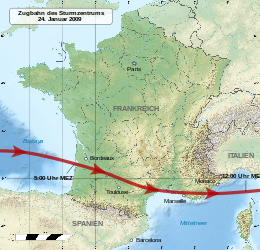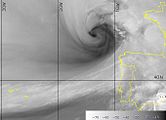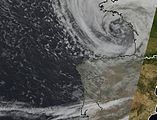Hurricane Klaus
| Hurricane Klaus | |
|---|---|
| Track of the hurricane | |
| Storm | Hurricane ( Va-Zugbahn ) |
| Data | |
| Arrival on the mainland | January 23, 2009 |
| resolution | January 25, 2009 |
| Air pressure drop | 34 hPa / 24 h (weather model, Spain) |
| tips gust | 216 km / h ( Coll d'Envalira , Andorra) |
| consequences | |
| affected areas | Spain , Andorra , France , Italy , Germany , Algeria |
| Victim | 32 |
| Damage amount | US $ 3.8 billion economically ($ 2.3 billion insurance loss) |
Hurricane Klaus was a powerful winter storm that hit northern Spain , southern France and parts of Italy from January 23 to 25, 2009 , causing considerable damage. At least 32 people were killed directly by the storm. Traffic was widespread interrupted or hindered. Météo-France described the damage as comparable to that caused by hurricane Lothar on December 26 and 27, 1999 . In Spain it was the worst storm since 1997.
Storm course
The origin of Hurricane Klaus (naming scheme of the FU Berlin ) was in the Atlantic Ocean north of the Azores . The cyclogenesis was explosive because, according to the calculation model of the Spanish weather service, the air pressure difference within twenty-four hours was 34 hPa . In the latitudes in which the Iberian Peninsula is located, one speaks of "explosive cyclogenesis" when the air pressure difference is more than about 19-20 hPa. The storm then moved across the Bay of Biscay . Its center crossed the French coast near Bordeaux on January 24th at 5:00 a.m.CET and then migrated from west to southeast across southwestern France. The hurricane hit the Atlantic coast with gusts of 170 km / h and reached 190 km / h in the mountains of the Aude and Pyrénées-Orientales .
The storm then moved across the Côte d'Azur to the Gulf of Genoa , where it had arrived at 12:00 on January 25th. The storm then disappeared over the Italian peninsula.
Effects
| speed | place | Country |
| 216 km / h | Coll d'Envalira |
|
| 198 km / h | Cerezo de Arriba |
|
| 193 km / h | Formiguères |
|
| 193 km / h | Machichaco |
|
| 184 km / h | Perpignan |
|
| 177 km / h | Saint-Paul-de-Fenouillet |
|
| 172 km / h | Biscarrosse |
|
| 172 km / h | Cap Ferret |
|
| 166 km / h | Cabo Peñas |
|
| 161 km / h | Bordeaux airport |
|
| 152 km / h | Pointe de Socoa |
|
| Sources: AEMET , Météo-France | ||
The effects of the Stum were felt from the Channel Islands to southern Germany in the north and south to Algeria and Sicily . The storm was strongest in southern France, where the regions of Aquitaine , Languedoc-Roussillon and Midi-Pyrénées were particularly affected, and in northern Spain, Catalonia and the Basque Country . The storm brought heavy rain. The peak gust was recorded at 216 km / h on the Coll d'Envalira in Andorra, the highest value in France was measured in Formiguères in the Pyrénées Orientales department at 193 km / h, the highest value in Spain in Cerezo de Arriba was 198 km / h H.
At some measuring points in France the hurricane reached a strength that exceeded all values previously measured there. In Perpignan, for example, the anemometer showed a peak gust that, at 184 km / h, exceeded the value measured during hurricane Lothar by 44 km / h, in Bordeaux the peak gust was 15 km / h stronger than during Lothar. Weather stations in Saint-Paul-de-Fenouillet , Biscarrosse , Bordeaux , Narbonne , Pointe de Socoa and Biarritz also reported new record values .
After the disastrous consequences of hurricane Lothar in 1999, which killed 88 people in France (the number 88 also includes the victims of storm Martin , which hit the south of France one day after Lothar), Météo-France also used the Meteoalarm warning system to make the public more effective warn (the system uses the colors green = no danger, yellow, orange and red = highest danger) to identify the warning levels. It was put into operation in October 2001. During the passage of the hurricane, Météo-France triggered the red warning level for nine departments. Although this was the fourth triggering of this warning level since 2001, this was the first time due to a wind event.
Numerous railway lines were out of service due to trees lying on the rails and damaged overhead lines . The TGV route Paris – Bordeaux, as well as the connections Bordeaux – Agen – Toulouse, Tarbes – Toulouse, Paris – Toulouse, Toulouse – Montpellier, Bordeaux – Périgueux and Bordeaux – Hendaye as well as numerous branch lines were affected. Flight operations at the airports in southwest France, including the international airports of Bordeaux and Toulouse , had to cease during the height of the storm.
The winds damaged houses, toppled trees and tore down utility lines. The French electricity network and the France Télécom telephone network were disrupted in some areas by the hurricane; More than 350,000 landline connections in southwest France were disrupted the day after Hurricane Klaus passed through. The cellular network was also disrupted because antenna systems were damaged by the hurricane or were without power. Between 25% and 75% of customers could not be reached depending on the department.
During the height of the hurricane in France, the electricity supply for 1.7 million consumers in the hardest-hit regions failed. In France, the secondary network between the substations and the consumers is mostly above ground. The blackout also put more than 400 level crossings out of operation because the signaling systems and barriers no longer worked and also caused interruptions in the supply of drinking water, which affected thousands in the Landes department and around 5,000 people in the Dordogne department .
According to initial estimates by the Fédération française des sociétés d'assurances (FFSA) - the French association of insurance companies - the property damage in France amounts to several hundred million euros .
The forests of Aquitaine were badly affected, in particular the pine forests in the Landes department and around the Bassin d'Arcachon were damaged by 60–80%. Many of these forests were only reforested after the devastation caused by Lothar and Martin , who moved through the region at the end of December 1999. Around 34,000 people in the region work in forestry , which has an annual turnover of 2.6 billion euros. In Aquitaine, 40,000 forest owners have more than 4 hectares of forest. Of the 1.7 million hectares of forest in the region, around one million hectares are monoculture overgrown with maritime pines . Lothar destroyed around 240,000 hectares of forest in 1999, and France and the European Union then paid out 250 million euros in grants and compensation.
As a result of the hurricane, numerous rivers burst their banks in the region.
In Spain, blackouts affected around 50,000 customers, most of them in Galicia, where 36,600 customers were without electricity, and 11,000 and around 2000 in the Basque Country. According to the network operator REE, 17 high-voltage lines in the north of the country were affected by the failures. In Galicia, the hurricane interrupted the telephone connection for 45,000 customers, 384 mobile radio stations were disrupted. More than 200 communities reported incidents, mostly fallen trees and utility masts.
The collapse of a high-voltage line caused a forest fire in the province of Alicante caused by sparks.
Damage balance
According to the Munich Reinsurance Company , hurricane Klaus caused damage totaling the equivalent of US $ 3.8 billion , of which US $ 2.3 billion was insured.
- Victim
| Country | Victim |
|---|---|
|
|
15th |
|
|
9 |
|
|
4th |
|
|
2 |
|
|
2 |
| All in all | 32 |
The storm killed at least 30 people in Europe; Extensions of the storm in North Africa killed two other people.
Spain
- Four children were killed and 16 others injured in the collapse of a sports facility in Sant Boi de Llobregat, southwest of Barcelona, on January 24. They had sought refuge from the storm in the hall when the strong wind shifted the roof and caused a wall to collapse.
- A police officer at Burela in Galicia and a road worker in La Palma de Cervelló in the province of Barcelona were killed by trees.
- A woman in Barcelona and a man in Aigües de Busot, Alicante province, were killed when the wall collapsed.
- The Portuguese captain of the cargo ship Braga died after he and his crew were rescued from distress 77 nautical miles northeast of A Coruña .
France
- Two drivers were killed by falling trees in the Landes department and in the south of France. Flying debris killed another man.
- A woman from the Landes department died of hypothermia .
- In the Gironde department , a woman died because her ventilator stopped working due to the power failure.
- Two elderly people died in Nanteuil-Auriac-de-Bourzac , Dordogne , from carbon monoxide poisoning from an emergency generator; The same cause has the death of two day trippers in Port-Barcarès , Département Pyrénées-Orientales .
Italy
- A woman was swept away by waves on the Amalfi coast while walking by the sea.
- Three occupants of a vehicle on the Reggio Calabria - Salerno motorway were buried in a landslide .
Algeria
- The foothills of the hurricane brought down a wall in Sétif in eastern Algeria, killing two people.
Germany
- A man was killed by a collapsing barn door in Gerabronn .
- A driver died as a result of a storm-related traffic accident.
Relief efforts
Electricité Réseau Distribution France (ERDF) has sent around 3,000 high voltage electricians to the region, some of whom were brought in from Portugal, the United Kingdom and Germany. France Télécom has mobilized around 3,000 technicians to repair the damage to the telephone network.
The French government sent around 700 soldiers from the Southwest Defense Area to the affected areas to help clear the roads from fallen trees and other debris. The affected region was declared a disaster area. President Nicolas Sarkozy demanded from the insurance companies "not only a lot of compensation, but also speed with the processing" .
Web links
- Collection of images, maps and data (French)
Individual evidence
- ↑ a b Ilse Schlingensiepen: Insurers pay a lot for natural disasters , Financial Times Germany of July 28, 2009.
- ↑ Weather sponsor campaign! . Institute for Meteorology, Free University of Berlin. Retrieved January 25, 2009. See also weather map from January 23, 2009
- ↑ Análisis preliminar de la situación del 22-25 de enero de 2009 ( Spanish , PDF) Agencia Estatal de Meteorología. January 26, 2009. Archived from the original on February 5, 2009. Retrieved on January 29, 2009.
- ↑ El fuerte temporal colapsa el suroeste francés y causa tres muertos ( Spanish ) El País. Retrieved January 27, 2009.
- ↑ Ciclogenesis explosiva_ 2325 01 2009 ( Memento of February 5, 2009 in the Internet Archive ) , AEMET (pdf).
- ↑ a b La tempête du 24 janvier 2009 ( Memento of February 8, 2009 in the Internet Archive ), Météo-France, 26/01/2009.
- ↑ Christophe Magdelaine: Tempêtes de décembre 1999 en France: les ouragans Lothar et Martin. MeteoFrance, September 11, 2013, accessed May 21, 2015 .
- ^ Tempête: France Télécom mise sur les groupes électrogènes pour rétablir les connexions ( French ) LeMagIT. January 26, 2009. Retrieved May 20, 2011.
- ↑ a b Sud-ouest: reprise progressive du trafic SNCF ( French ) Le Parisien . January 26, 2009. Retrieved January 28, 2009.
- ^ A b La tempête "Klaus" au sud de la France ( French ) Radio Suisse Romande . January 26th, 2009. Accessed on January 28th, 2009. ( Page no longer available , search in web archives ) Info: The link was automatically marked as defective. Please check the link according to the instructions and then remove this notice.
- ↑ a b c Estelle Shirbon, Sonya Dowsett: France, Spain pick up pieces after deadly storm ( English ) Reuters . January 25, 2009. Retrieved January 28, 2009.
- ↑ a b c Après la tempête, la vie tente de reprendre son cours dans le Sud-Ouest ( French ) Agence France Presse . January 26, 2009. Retrieved January 28, 2009.
- ↑ Tempête - L'électricité rétablie dans 100% des foyers jeudi? ( Memento of February 3, 2009 in the Internet Archive ), tf1.lci.fr
- ↑ La forêt en Aquitaine dévastée par endroits à 60% ( French ) Agence France-Presse . January 25, 2009. Retrieved January 28, 2009.
- ^ A b Klaus: les assureurs sous pression ( French ) Le Monde . January 26, 2009. Retrieved January 28, 2009.
- ↑ a b Los niños estaban enterrados en piedras ( Spanish ) El País . January 25, 2009. Retrieved January 28, 2009.
- ↑ a b c d e f Spain and France battered by deadly storm ( English ) Agence France-Presse . January 25, 2009. Archived from the original on January 29, 2009. Retrieved January 27, 2011.
- ↑ Tempête: au moins 600 millions d'euros de dégâts, selon les assurances ( French ) Associated Press . January 26, 2009. Archived from the original on January 27, 2009. Retrieved January 27, 2011.
- ^ Tempête Klaus: mobilization face aux dégâts, désastre dans les forêts ( French ) Le Point . January 25, 2009. Archived from the original on January 28, 2009. Retrieved January 27, 2011.
- ^ Romandie Infos, January 26, 2009
- ↑ Le Figaro, January 26, 2009


